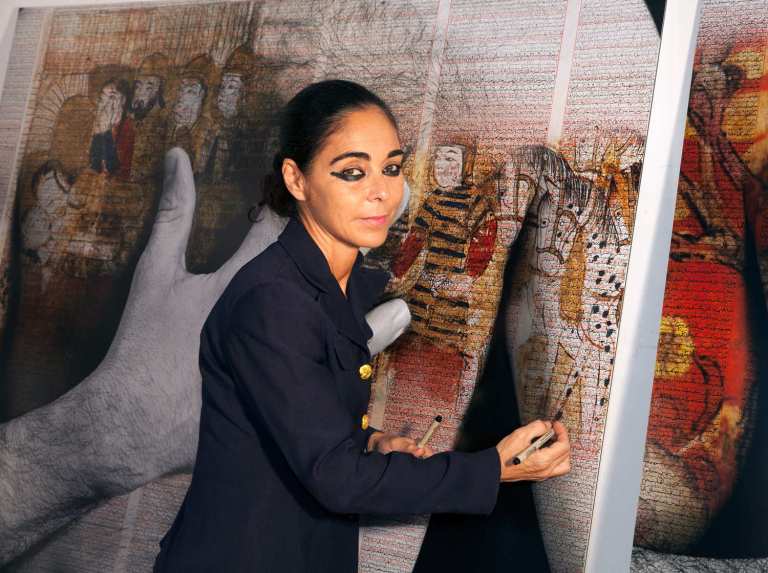Photographs from Shirin Neshat sell for over $100,000. Her works can be found in the permanent collections of London’s Tate Gallery and New York’s MOMA. Her films and video installations have won international acclaim. In 2015, photography legend Annie Leibovitz selected Neshat as one of the world’s most inspiring women.
Yet all this success comes from art spawned by the pain of exile and displaced identity. Neshat cannot go home to her native Iran, which transformed itself in the late 1970s while she studied at UC Berkeley. Neshat’s art attempts to make sense of this deep rupture, which forever transformed her life.
Now, The Broad modern art museum in Los Angeles is spotlighting Neshat’s artistic journey over the past three decades with a new retrospective with the hopeful title: “I Will Greet the Sun Again.” Visitors can explore over 230 photographs and eight immersive videos produced by Neshat from the early 1990s until today, including several portraits made in Iran being exhibited publicly for the first time.
From Qazvin to California to SoHo
Growing up in Qazvin, Iran’s one-time capital and a city renowned for calligraphy, Neshat both embraced modern possibility and venerated her heritage. “We celebrated all the festivities that were rooted back to our ancestors,” she observes. “I represent a generation of people who lived with this double identity of Persian and Muslim. And we were at peace with that.”
Neshat’s parents sent her to Los Angeles to finish high school. After that, she continued on to Berkeley for undergraduate and graduate degrees in art. Then the Iranian Revolution hit. “The money my parents were sending me stopped. The borders closed and I had to support myself. There was no communication with Iran. This was also at the time that the hostages were taken.”
Neshat became increasingly unhappy and unsatisfied with her art. One day in 1983, she suddenly flew to New York, leaving behind her apartment, her then-boyfriend, and all her art. She started working at a small gallery in SoHo, married Korean artist Kyong Park, and had a son named Cyrus. But her artistic output remained stunted.
A Return Visit to Iran Inspires Shirin Neshat
By 1990, the Iran-Iraq War had ended. Neshat returned home to Iran for the first time in over a decade. The changes shocked her. “Iran had been turned upside down,” she recalls. Her own mother and sisters had “undergone a tremendous change from being quite European or Westernised in their style of fashion.” All wore veils in public.
Neshat struggled to make sense of her homeland’s and her family’s transformation. She produced a series of black-and-white self-portrait photographs titled “Women of Allah.” Inspired by Iranian regime propaganda images of veiled women holding weapons, Neshat depicted herself wearing a chador. Atop her face, feet, and hands – the only women’s body-parts the regime allowed showin in public – Neshat overlaid calligraphy of modern Persian poetry, including the phrase “I will greet the sun again.”
Neshat’s series debuted in 1995 at New York’s Annina Nosei Gallery. It quickly caught the eye of photography superstar Cindy Sherman, who became the first person ever to purchase one of Neshat’s works. The exhibition also generated controversy. “Everything I have ever done has generated a lot of debate, and not all of it has been praise,” admits Neshat.
Neshat’s international breakthrough came in 1999 when her split-screen video “Turbulent” won a Golden Lion top prize at the Venice Biennale. She went on to collaborate with composer Philip Glass on “Passage,” a video exploring the rituals of a Muslim funeral ceremony. Neshat’s debut feature film “Women Without Men” earned her the best director prize at the 2009 Venice Film Festival for its study of women in Tehran amidst a 1953 coup d’etat.
Shirin Neshat Comes to Terms with the Past and the Present
Over the past decade, Neshat has shifted her focus from Iran. More recent works explore subjects in Azerbaijan, Mexico, and even America’s southwest. In 2014, she made an experimental film on iconic Egyptian singer Umm Kulthum.
Meanwhile, Neshat still cannot return to her homeland, forcing her to miss the funerals of her father and brother. “The authorities detained me at the airport [in the mid 1990s], and many people have told me it’s not a good idea for me to go back,” she reveals.
Neshat now lives in Brooklyn with her partner and collaborator Shoja Azari, a fellow expatriate Iranian artist. Surviving in exile has become the driving motif of Neshat’s art. Yet, she does not want to be prisoner to nostalgia and longing.
“I don’t have to go on forever creating this sense of memory and clinging to something that doesn’t want me back,” observes Neshat. “It’s about accepting this nomadism in my life.”
The Broad exhibit “I Will Greet the Sun Again” runs through February 16.



